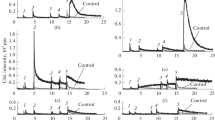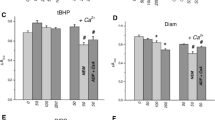We studied membranotropic properties of NO donor 2-nitroxysuccinate 3-hydroxy-6-methyl-2-ethylpyridine and its structural analog succinate 3-hydroxy-6-methyl-2-ethylpyridine (Mexidol). It was shown that the compounds under study are incorporated into modeled membranes and form long-living complexes with pyrene in the region of fatty acid tails of phospholipids. Luminol-amplified chemiluminescence analysis showed that both compounds exhibited antiradical activity and in a concentration of 0.1 mM reduced chemiluminescence intensity by more than 70%. 2-Nitroxysuccinate 3-hydroxy-6-methyl-2-ethylpyridine inhibited catalytic activity of monoamine oxidase A more efficiently than its structural analogue Mexidol.
Similar content being viewed by others
References
Fedorov BS, Fadeev MA, Varfolomeev VN, Retskij MI, Bliznetsova GN, Neborak EV. Patent RU No. 2394815. Nitroxy-succinate 2-ethyl-6-methyl-3-oxypyridine (versions of use) and method of producing said compound. Bull. No. 20. Published July 20, 2010.
Poletaeva DA, Kotel’nikova RA, Mischenko DV, Rybkin AY, Smolina AV, Faingol’d II, Troshin PA, Kornev AB, Khakina EA, Kotel’nikov AI. Estimation of membrane activity of water-soluble polysubstituted fullerene derivatives by luminescence methods. Nanotechnologies in Russia. 2012;7(5-6):302-307.
Afanas’ev I. ROS and RNS signaling in heart disorders: could antioxidant treatment be successful? Oxid. Med. Cell. Longev. 2011;2011. 293769. doi: 10.1155/2011/293769.
Bortolato M, Chen K, Shih JC. Monoamine oxidase inactivation: from pathophysiology to therapeutics. Adv. Drug Deliv. Rev. 2008;60(13-14):1527-1533.
Corbineau S, Breton M, Mialet-Perez J, Costemale-Lacoste JF. Major depression and heart failure: Interest of monoamine oxidase inhibitors. Int. J. Cardiol. 2017;247:1-6.
Di Meo S, Venditti P, Piro M. C, De Leo T. Enhanced luminescence study of liver homogenate response to oxidative stress. Arch. Physiol. Biochem. 1995;103(2):187-195.
Halliwell B. Free radicals and antioxidants: updating a personal view. Nutr. Rev. 2012;70(5):257-265.
Mialet-Perez J, Bianchi P, Kunduzova O, Parini A. New insights on receptor-dependent and monoamine oxidase-dependent effects of serotonin in the heart. J. Neural. Transm. (Vienna). 2007;114(6):823-827.
Mocellin S. Nitric oxide: cancer target or anticancer agent? Curr. Cancer Drug Targets. 2009;9(2):214-236.
Nikolaeva NS, Aksinenko AY, Kinzirsky AS, Soldatova YV, Smolina AV, Sokolov VB, Kotelnikova RA, Shtolko VN, Kotelnikov AI. Effect of fluorinated tetrahydrocarbazole derivatives on the enzymes of oxidative deamination of biogenic amines and on the process of lipid peroxidation. Russ. Chem. Bull. 2017;66(5):870-874.
Peetla C, Stine A, Labhasetwar V. Biophysical interactions with model lipid membranes: applications in drug discovery and drug delivery. Mol. Pharm. 2009;6(5):1264-1276.
Wanstall JC, Jeffery TK, Gambino A, Lovren F, Triggle CR. Vascular smooth muscle relaxation mediated by nitric oxide donors: a comparison with acetylcholine, nitric oxide and nitroxyl ion. Br. J. Pharmacol. 2001;134(3):463-472.
Witte MB, Barbul A. Role of nitric oxide in wound repair. Am. J. Surg. 2002;183(4):406-412.
Youdim MB, Edmondson D, Tipton KF. The therapeutic potential of monoamine oxidase inhibitors. Nat. Rev. Neurosci. 2006;7(4):295-309.
Author information
Authors and Affiliations
Corresponding author
Additional information
Translated from Byulleten’ Eksperimental’noi Biologii i Meditsiny, Vol. 167, No. 6, pp. 700-703, June, 2019
Rights and permissions
About this article
Cite this article
Poletaeva, D.A., Faingold, I.I., Soldatova, Y.V. et al. Membranotropic and Antiradical Properties of 2-Nitroxysuccinate 3-Hydroxy-6-Methyl-2-Ethylpyridine. Bull Exp Biol Med 167, 744–746 (2019). https://doi.org/10.1007/s10517-019-04613-x
Received:
Published:
Issue Date:
DOI: https://doi.org/10.1007/s10517-019-04613-x




